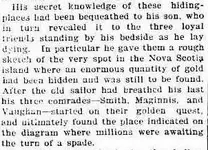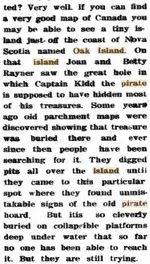Emerging from the development of this reconstruction is the possibility of the existence of a Geometrical Swamp. This is shown in the diagram below with two points potentially marking documented features of the island: a Drilled Rock just offshore at Joudrey’s Cove and three large piles of Stones in the form of an isosceles triangle pointing into the middle of the swamp. All efforts over the years to obtain information about these features from the owners have failed, so their positions are highly speculative.
The centre of the Geometrical Swamp as suggested here doesn’t coincide with the so-called ‘Eye of the Swamp’, but could be pertinent to the deposit. This is simply an observation that emerged some years ago, bearing in mind that the ground plan here was first published some fifteen years ago showing both the Geometrical Swamp and an assumed deposit location.
This illustrated a suggestion, presented at the time on Jo Atherton’s Oak Island forum, that had there been a treasure then it may have been deposited by tunnel from the centre of the swamp. The thought was that a huge treasure wouldn’t have been carried down the Money Pit and along low and narrow tunnels on the backs of the diggers.
It would have been better to excavate a large tunnel, preferably level with a down-slope at point of entry, but as there was no trace of such then this may have been obliterated by creating the swamp so that the entrance couldn’t be found and used as a back door. However, it was appreciated that this would have required a very long tunnel, perhaps militating against the idea.
The distance from the centre of the swamp to the assumed deposit point can be calculated as the sum of 60 rods magnetic east and then 5 rods magnetic south for a total of 65 rods or 1073 feet (actually 1072.5). Initially, I postulated the presence of a square chamber perhaps with sides of one rod (16.5 feet) centred on the ‘X’ as at top left below. However, I also considered a variation that wouldn’t result in crashing through the roof onto the treasure by aligning the south wall on the ‘X’, as at top right in the figure.
I didn’t calculate the distance to the deposit at the time, but this would be 1065 feet. Although I have my suspicions about the encryption and the French language of the La Formule cipher it seemed strange that this is the length of the passageway described in the plaintext. The text is reported to read: “The [corridor] at 1065 feet reaches the chamber.” Note that this would not be the French foot of 12.8 inches but the British foot.
The distance on the ground plan as above is actually 64.5 rods or 1064.25 feet. This could well be coincidence, but then I thought to investigate the first part of the plaintext which is reported to read: “Dig at 40 feet with the angle 45 degrees. The shaft at 522 feet at your entry.”
It so happens that should the deposit lie 40 feet below the surface (or 60 links), digging a tunnel at 45 degrees from the midpoint of the first stretch of the passageway (30 rods from the start, that is, point B in the lower diagram above) would cause the searcher to break into the tunnel (at point C) the reported 522 feet from the assumed chamber entrance (point E). The distance on the ground plan would be 790 links or 521.4 feet.
The options seem to be that this could also be coincidence, or that the cipher could have been devised with knowledge of this ground plan, or that it matches the ground plan because it’s part of the original documentation that includes the maps. The second would be out of the question should the cipher have been in the McGinnis family for generations, as is reported (see
Oak Island Connection by Kerrin Margiano).
In the event the plaintext is based on an original document, this could be yet another case of someone using genuine documentation in a hoax. That is, the basis of the plaintext is original but has been manipulated, perhaps thereby losing some context, to make it appear to apply to Oak Island by using the Kempton cipher (as on the stone reported to be at 90 feet) and also to appear to be of French origin.
The plaintext said to be on the stone, the earliest publication of which I’ve seen being 1947, could simply have been deduced from the original Formule document.
Needless to say, I’m still sceptical, but also intrigued. I don’t find the Formule plaintext particularly convincing as a means to recover a deposit (a slope of 45 degrees?), but it could simply be a way to provide conformation that the ground plan is correct. There may be no actual tunnel, just as there would likely be no treasure at the map points.







